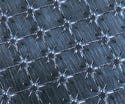High-Energy E-Beam Process Enables Enhanced Surface Modification
July 4, 2007
Originally Published MPMN July/August 2007
BREAKTHROUGHS
High-Energy E-Beam Process Enables Enhanced Surface Modification
|
The Surfi-Sculpt E-beam process enables pattern generation without any additives. |
Many surface modification processes may deposit powders or employ chemicals to achieve a desired pattern on a device’s surface. But with Surfi-Sculpt, a recently introduced high-energy electron-beam process, whichever base metal you provide is the only material you get back after treatment.
Capable of modifying surface characteristics of metal with exact tolerances and repeatability, the technology generates a pattern without any sort of additives. EBTEC Corp. is currently the only company licensed to offer such a service in the United States.
“We start out with whatever material you have—a flat plate or tubes—and basically this process creates the pattern out of the parent material,” says EBTEC president John Leveille. The process entails the use of electrons controlled through focus and deflection coils into a stream of energy. Patterns are created on a computer and are then transferred directly to the application.
Metal applications typically chemically etched or welded with E-beam technology are prime candidates for the process. Any type of ferrous or nonferrous alloys can undergo Surfi-Sculpt; Leveille even ventures to say that the more precious the material, the better the pattern outcome.
Among the devices that stand to benefit from the surface modification process are orthopedic implants. Rough surfaces fashioned by the process could help facilitate bone growth to the implant, which is desirable to stabilize and fortify the joint.
The firm also extols the Surfi-Sculpt’s competence in providing nonslip grips for such surgical instruments as rib spreaders and forceps. Some instruments are hardened, which prevents them from being machined and patterned; the Surfi-Sculpt process bypasses that developmental hurdle, Leveille says. Moreover, since there are no added substances or chemicals applied in the procedure, the problem of material flaking off instruments during autoclaving is eliminated.
Although Leveille speculates that there may be height limitations for the process, he points out that patterns can be produced that are almost microscopic and surface possibilities are seemingly limitless, unlike with such processes as chemical etching. “Pretty much whatever the mind can create, we can transfer it onto metal,” he affirms.
EBTEC Corp., Agawam, MA
www.ebteccorp.com
Copyright ©2007 Medical Product Manufacturing News
You May Also Like


.png?width=300&auto=webp&quality=80&disable=upscale)
